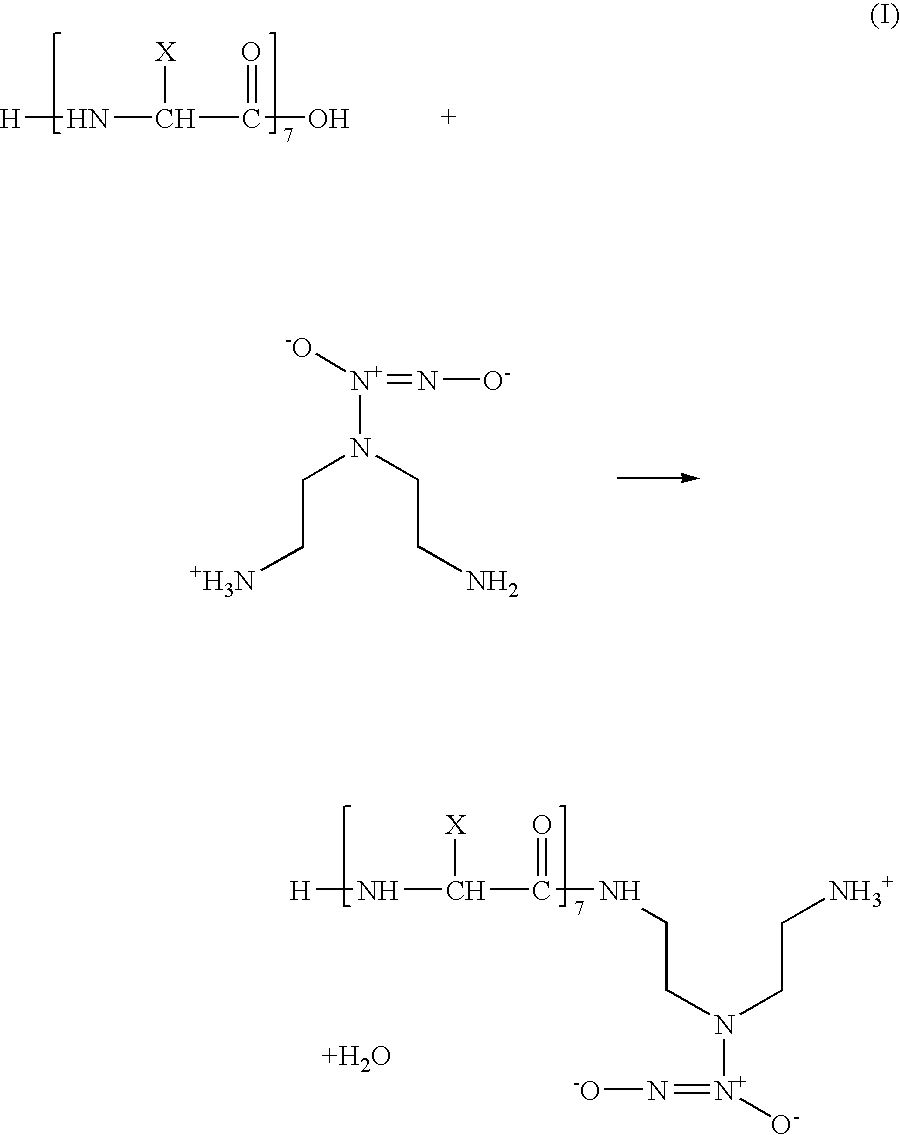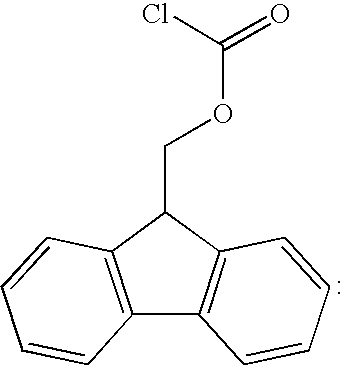Coatings for implantable medical devices incorporating chemically-bound polymers and oligomers of L-arginine
a technology of arginine and stents, which is applied in the field of coatings for medical devices, can solve the problems of insufficient treatment, l-arginine coating into stents, and often toxic side effects of systemic administration of medications, and achieve the effect of inhibiting or eliminating restenosis of blood vessels
- Summary
- Abstract
- Description
- Claims
- Application Information
AI Technical Summary
Benefits of technology
Problems solved by technology
Method used
Image
Examples
example 1
[0027]R7 can be grafted to EVAL. Optionally, an NO donor, such as DETA-NO can be first conjugated to R7. EVAL with m:n ratio of 44:56 can be used. EVAL with a higher or lower ethylene content can be modified by the same methods as those discussed below. The first optional step of grafting includes conjugation of DETA-NO to R7 utilizing an amide linkage with R7 according to the following reaction scheme (I):
[0028]
[0029]A variation of reaction (I) includes cross-linking of R7 with DETA-NO using a imidoester cross-linking agent, such as dimethyl adipimidate (DMA), dimethyl pimelimidate (DMP) or dimethyl 3,3′-dithiobispropionimidate (DTBP). DMA, DMP and DTBP are manufactured commercially by Pierce Corp. of Rockford, Ill.
[0030]Next, EVAL can be halogenated by phosphorous trichloride PCl3, phosphorous pentachloride PCl5 thionyl chloride SOCl2, or other appropriate halogenating agent, via EVAL's hydroxyl group. This process, a nucleophilic substitution SN2 can be schematically illustrated ...
example 2
[0038]DETA-NO can be optionally grafted to R7 as shown in Example 1, reaction (I). Next, the non-protonated, non-terminal primary amino groups of R7 are protected by reaction with 9-fluorenylmethyl chloroformate in aqueous dioxane as shown in Example 1, reaction (III).
[0039]The reaction of direct esterification is then carried out, as a result of which, the carboxyl group of R7 is conjugated to EVAL in the presence of 1,3-dicyclohexylcarbodiimide (DCC) having the formula
[0040]
wherein, DCC activates the carboxyl group of R7, thus facilitating the esterification reaction of nucleophilic substitution (V):
[0041]
where L is defined in Example 1.
[0042]Reaction (V) is conducted under standard conditions known to those having ordinary skill in the art. An insoluble substance, N,N-dicyclohexylurea, having the formula
[0043]
is a by-product of the reaction (V). Finally, the R7-EVAL conjugate, the product of reaction (V), is de-protected by a reaction with morpholine or another appropriate amine,...
example 3
[0046]The preparation of EVAL-R7 conjugate is similar to Example 1, but the order of steps can be different. First, the non-protonated, non-terminal primary amino groups of R7 are protected by reaction with 9-fluorenylmethyl chloroformate in aqueous dioxane as shown in Example 1, reaction (III). Next, EVAL is reacted with the protected R7. This can be accomplished using preliminarily halogenated EVAL as shown by reaction (IV), Example 1. Alternatively, a direct esterification in the presence of DCC or DMAP can be used as in Example 2.
[0047]Next, DETA-NO can be optionally grafted to R7 as shown in Example 1, reaction (I). Instead of DMA, DMP or DTBP, discussed in Example 1, a di-succinimidyl ester in a non-aqueous solvent (e.g., dimethyl acetoamide) can be used at a temperature of about 40° C. in a slightly basic medium (e.g., pH˜7.4) to perform the cross-linking of DETA-NO with R7. Examples of suitable di-succinimidyl esters include bis(succinimidooxycarbonyloxyethyl sulfone) (BSOCO...
PUM
| Property | Measurement | Unit |
|---|---|---|
| temperature | aaaaa | aaaaa |
| concentration | aaaaa | aaaaa |
| mechanical | aaaaa | aaaaa |
Abstract
Description
Claims
Application Information
 Login to View More
Login to View More - R&D
- Intellectual Property
- Life Sciences
- Materials
- Tech Scout
- Unparalleled Data Quality
- Higher Quality Content
- 60% Fewer Hallucinations
Browse by: Latest US Patents, China's latest patents, Technical Efficacy Thesaurus, Application Domain, Technology Topic, Popular Technical Reports.
© 2025 PatSnap. All rights reserved.Legal|Privacy policy|Modern Slavery Act Transparency Statement|Sitemap|About US| Contact US: help@patsnap.com



